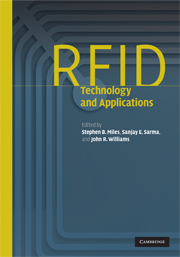Book contents
- Frontmatter
- Contents
- List of contributors
- Preface
- Acknowledgments
- 1 Introduction to RFID history and markets
- 2 RFID technology and its applications
- 3 RFID tag performance optimization: a chip perspective
- 4 Resolution and integration of HF and UHF
- 5 Integrating sensors and actuators into RFID tags
- 6 Performance evaluation of WiFi RFID localization technologies
- 7 Modeling supply chain network traffic
- 8 Deployment considerations for active RFID systems
- 9 RFID in the retail supply chain: issues and opportunities
- 10 Reducing barriers to ID system adoption in the aerospace industry: the aerospace ID technologies program
- 11 The cold chain
- 12 The application of RFID as anti-counterfeiting technique: issues and opportunities
- 13 Closing product information loops with product-embedded information devices: RFID technology and applications, models and metrics
- 14 Moving from RFID to autonomous cooperating logistic processes
- 15 Conclusions
- Appendix – links to RFID technology and applications resources
- Editor biographies
- Index
- References
2 - RFID technology and its applications
Published online by Cambridge University Press: 02 November 2009
- Frontmatter
- Contents
- List of contributors
- Preface
- Acknowledgments
- 1 Introduction to RFID history and markets
- 2 RFID technology and its applications
- 3 RFID tag performance optimization: a chip perspective
- 4 Resolution and integration of HF and UHF
- 5 Integrating sensors and actuators into RFID tags
- 6 Performance evaluation of WiFi RFID localization technologies
- 7 Modeling supply chain network traffic
- 8 Deployment considerations for active RFID systems
- 9 RFID in the retail supply chain: issues and opportunities
- 10 Reducing barriers to ID system adoption in the aerospace industry: the aerospace ID technologies program
- 11 The cold chain
- 12 The application of RFID as anti-counterfeiting technique: issues and opportunities
- 13 Closing product information loops with product-embedded information devices: RFID technology and applications, models and metrics
- 14 Moving from RFID to autonomous cooperating logistic processes
- 15 Conclusions
- Appendix – links to RFID technology and applications resources
- Editor biographies
- Index
- References
Summary
While the origins of RFID lie more than 50 years in the past, passive RFID technology is actually only in its infancy. This might seem an odd statement given that other technologies which have had a comparable history – computers for example – are considered mature. What makes RFID different?
The reason is that RFID, perhaps more than other technologies, is a systems technology that transcends the reader and the tag. Readers and tags are rarely, if ever, used alone. They are components of much larger systems, some of which they augment, and many of which they fundamentally enable. There are many other components to the system in which RFID participates, and, for RFID to really blossom, every component of the system must blossom. So every new advance in, say, battery technology or networking will launch a new wave of creativity and invention in RFID. This will create new applications. These new applications will increase the demand for products, further subsidizing research, and thus laying the seeds for the next invention and the next wave. It is my firm belief that RFID is currently only in its first wave.
EPC technology, developed first by the Auto-ID Center and then by EPCglobal, probably represents the state-of-the-art of the first wave of RFID. Today, EPC tags are being deployed worldwide in thousands of sites and billions of EPC tags have been read. Passive EPC tags are being used for intra- and inter-company applications on a scale perhaps never seen before.
- Type
- Chapter
- Information
- RFID Technology and Applications , pp. 16 - 32Publisher: Cambridge University PressPrint publication year: 2008
References
- 2
- Cited by



